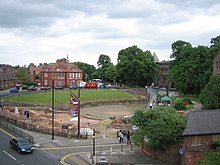Our website is made possible by displaying online advertisements to our visitors.
Please consider supporting us by disabling your ad blocker.
Chester Roman Amphitheatre
 The amphitheatre seen from the city walls, with archaeological digs in progress (2006) | |
| Location | Chester, Cheshire, England |
|---|---|
| Region | Brittania |
| Coordinates | 53°11′21″N 2°53′13″W / 53.18917°N 2.88694°W |
| Type | Amphitheatre |
| Part of | Deva Victrix |
| Length | 320 feet (98 m) |
| Width | 286 feet (87 m) |
| Area | 91,520 square feet (0.85 ha) |
| Height | 40 feet (12 m) |
| History | |
| Founded | Late 70's |
| Abandoned | Around 350 |
| Periods | Roman Empire |
| Site notes | |
| Management | English Heritage |
| Website | Chester Roman Amphitheatre |
Chester Amphitheatre is a Roman amphitheatre in Chester, Cheshire. The site is managed by English Heritage; it is designated as a Grade I listed building,[1] and a scheduled monument.[2][3] The ruins currently exposed are those of a large stone amphitheatre, similar to those found in Continental Europe, and although it was long believed that a smaller wooden amphitheatre existed on the site beforehand, excavations since 1999 have shown that the wooden grillage is the base of the seating. Today, only the northern half of the structure is exposed; the southern half is covered by buildings, some of which are themselves listed.[4]
The amphitheatre is the largest so far uncovered in Britain, and dates from the 1st century, when the Roman fort of Deva Victrix was founded. It is a peculiarly English myth that the amphitheatre would have been primarily for military training and drill; all the evidence recovered from excavation shows that it was used for cock fighting, bull baiting and combat sports, including classical boxing, wrestling and, probably most importantly, gladiatorial combat.[4] The poet Oppian wrote that the Romans inherited the Greek passion for the cockfight, which was held "on anniversaries ... as a solemn rite", a consecration, in effect a sacred cockfight, to remind men that they should be "perpetual imitators of the cock".[5]
In use through much of the Roman occupation of Britain, the amphitheatre fell into disuse around the year 350. The amphitheatre was only rediscovered in 1929, when one of the pit walls was discovered during construction work. Between 2000 and 2006, excavation of the amphitheatre took place for Chester City Council and, after 2004, English Heritage.[6]
- ^ Historic England, "Remains of Roman amphitheatre, Chester (1375863)", National Heritage List for England, retrieved 5 July 2013
- ^ Historic England, "Roman Amphitheatre (69224)", Research records (formerly PastScape), retrieved 31 March 2009
- ^ Historic England, "Roman amphitheatre (southern part), Chester (1004638)", National Heritage List for England, retrieved 5 July 2013
- ^ a b The Chester Amphitheatre, B&W Pics, retrieved 30 July 2007
- ^ Smith, Page; Daniel, Charles (27 April 2000). The Chicken Book. University of Georgia Press. pp. 72–73. ISBN 9780820322131.
- ^ Amphitheatre project, Chester.gov.uk, archived from the original on 16 April 2013 Retrieved on 14 August 2012.
Previous Page Next Page



